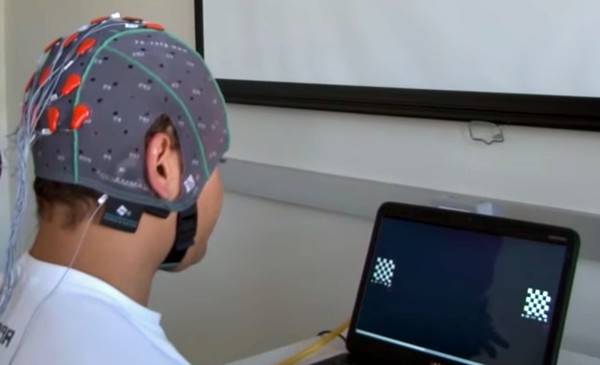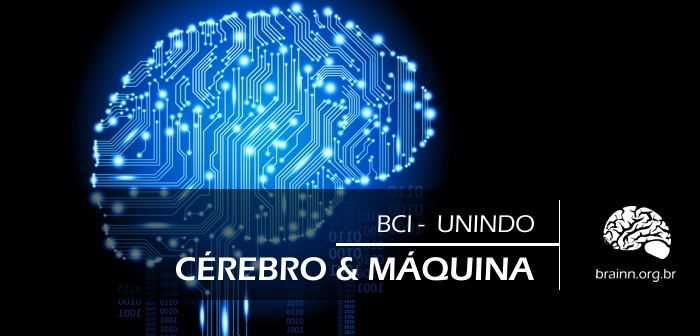Algorithms process brain signals and perform tasks previously impossible for people with mobility difficulties.
May 24th, 2016
by Erik Nardini Medina *
Imagine how it would feel for a person with a high degree of motor impairment to have a little bit more independence. Tasks of different complexities are now possible through a methodology called BCI. The Brain Computer Interface is far from being a new subject. However, it is an area that always reinvents itself and brings about both small and great achievements.
Researcher André Ferreira, of the Electrical Engineering Department at the Federal University of Espírito Santo (UFES), said that a number of activities can be done – incredible as it may seem! – using the power of thought, thanks to a paradigm called motor imagery.
“You just have to think, for example, of moving the right hand, or think of moving your feet. You don´t have to actually do the movement – the person sometimes is not able to–, just imagine it and the system detects the thought. This is much more intuitive and you do not depend on external stimuli, but it requires a whole period of learning”, explains Ferreira.
The patient just have to think of performing a movement (including moving a paralyzed limb) for the system to recognize his intention and transmit the command to the machine.
HOW CAN THE BRAIN COMMUNICATE WITH THE MACHINE?
In order to achieve results like these, the brain needs to communicate without interference with the computer. That takes place through three main stages: signal processing, feature selection and classification.

In short, the first step amplifies data extracted from the brain via electroencephalogram. In the second step, the researchers isolate the data, and in the third the information is sorted so it can be recognized with precision by the computer – as summarizes Professor Dr. Romis Attux, of the School of Electrical and Computer Engineering (FEEC) at the State University Campinas (Unicamp).
“We basically process signals from electroencephalography (EEG). These are electrical signals, electrical potentials measured on the scalp region, and the purpose of the proceeding is to improve the quality of the signals so that we can then translate user intent – which will be passed to us by his brain – into a command, to be used for example by a robotic wheelchair or some other destination”, explains Attux, who is also a researcher at the Brazilian Institute of Neuroscience and Neurotechnology (BRAINN).
DIVERSE USES FOR THE TECHNOLOGY
In addition to motor imagery, which allows users to perform tasks just by thinking about what they want to do, there are other resources the scientists may employ to help people with disabilities. One of them, widely used, is the SSVEP. In this method, a computer screen emits light stimuli at different frequencies. These signals are picked up by an electroencephalogram and are then processed, so that the computer understands which action the user plans to execute.

In this example of BCI in action, a user wears a ‘helmet’ with electrodes and is thus able to move, remotely, the little red car. Watch the demonstration in the video below.
“[The SSVEP] are the permanent state visually evoked potentials. Basically, if I present you a light stimulus at a given frequency, when we look at the EEG in the occipital part of the brain (which is responsible for the visual areas), you will see that that stimulation frequency will have a peak power”, says Ferreira, adding:
“What are we able to do then? I present you with different actions, each blinking at a different frequency. For example, I put an arrow to turn left at a 10 hertz frequency. An arrow to turn right, another frequency. Then the user simply looks, focus on the visual stimuli, and the EEG is contaminated by this stimulus and the software recognizes and performs the necessary action. ”
With the SSVEP paradigm, the user transmits his intentions to the machine by fixing his gaze on light stimuli. He does not have to do anything beyond that.
AN ELECTRODE ‘HELMET’ TRANSMITS THE SIGNALS

Professor Romis Attux / BRAINN.
For BCI to happen, the user stays with electrodes attached to the head (as shown in the above pictures). These devices are on the outside of a ‘helmet’, so there´s no need for surgery or other medical procedures. In the case of motor imagery, the researchers found that the simple act of imagining a movement is enough to generate activity in the motor cortex, and is right in this region that the electrodes are implanted.
“We use the same electrodes. But on the imagery techniques we focus our attention on the electrodes which are in the motor cortex, and on the SSVEP we work primarily with the electrodes that are close to the visual cortex. Thus, we are able to detect information that the person is picking up visually. But the electrodes are the same, “says Attux.
Now that you understand a little more about what the BCI, you can watch movies like “Phenomenon,” in which John Travolta takes control of things with the mind, “X-Men” or “Matrix” with a much more critical look!
* Journalist graduated from the Pontifical Catholic University of Campinas (PUC-Campinas), student of Science Journalism specialization at the Advanced Studies in Journalism Laboratory (Labjor / Unicamp). Has a MídiaCiência / FAPESP scholarship.










 Português do Brasil
Português do Brasil